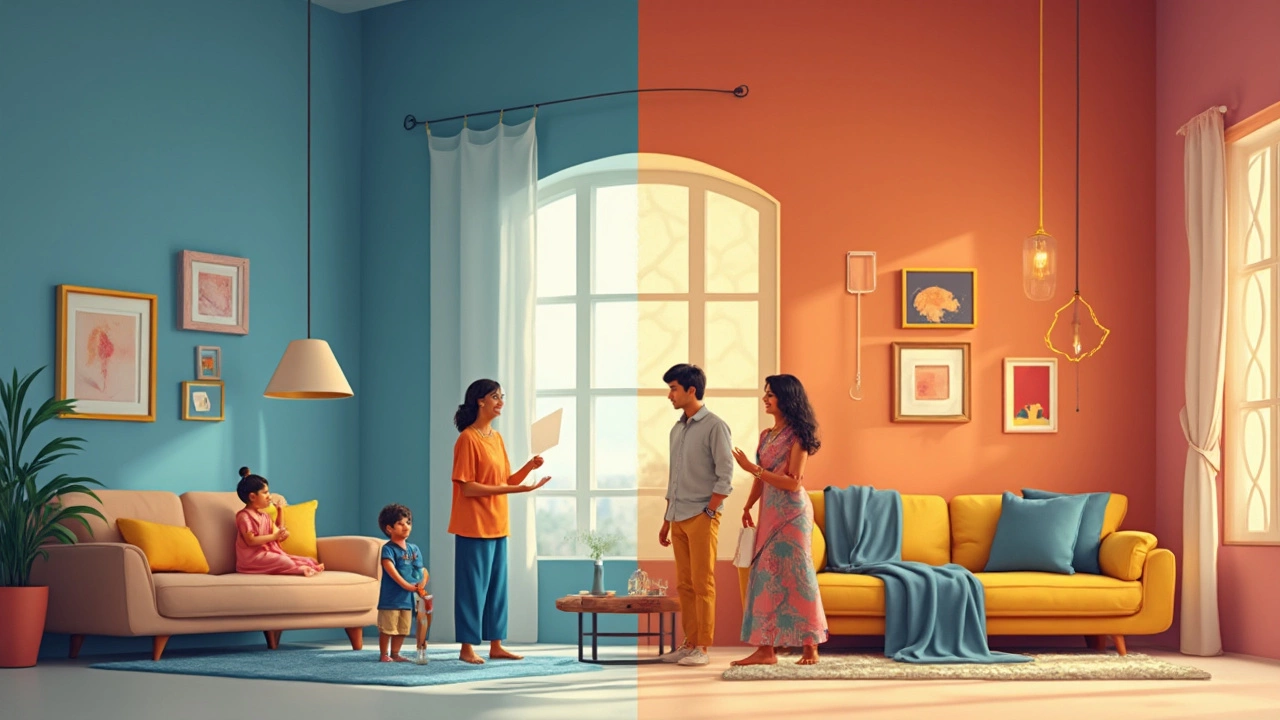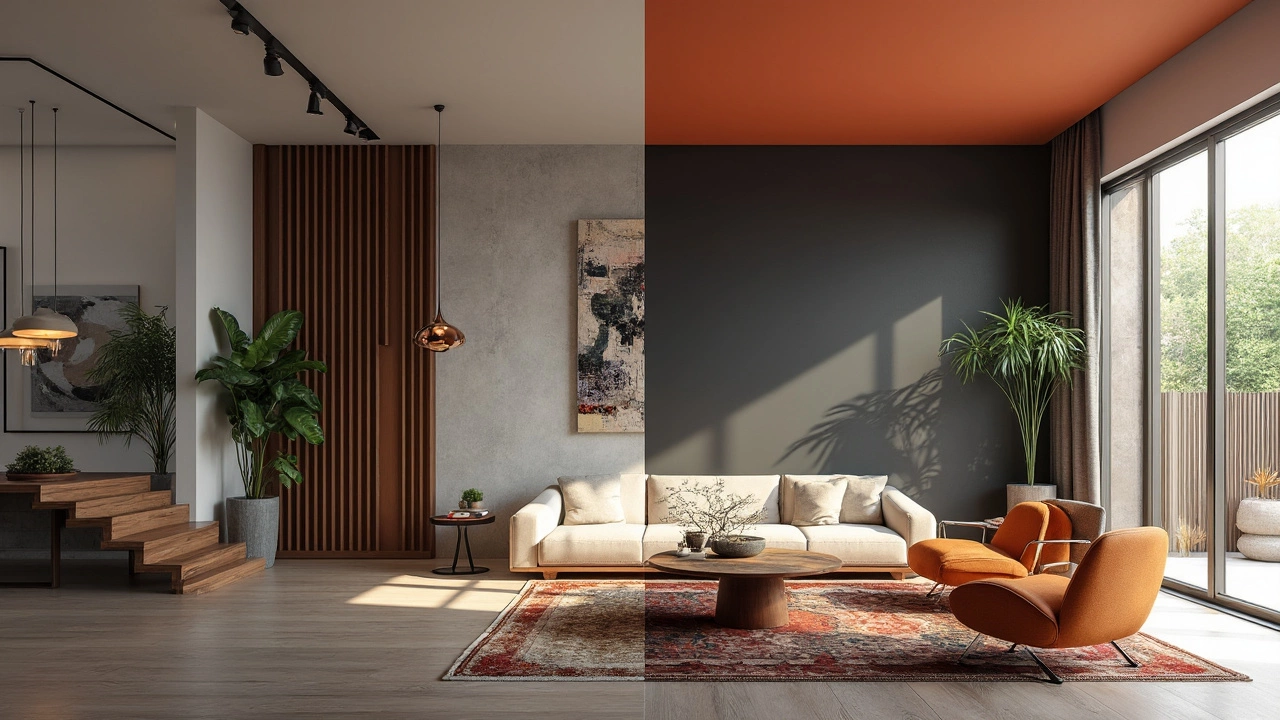You’ve probably heard people toss around “modern” and “contemporary” like they mean the same thing when talking about home interiors. Here’s the kicker—they’re not. If you walk into a home that’s truly modern, it won’t look like one that’s shaped by today’s trends. Getting these two mixed up can quietly derail your entire room makeover, especially if you grab a bunch of pieces that don’t play well together.
Think of it this way: choosing between modern and contemporary sets the whole vibe for your space, down to the shelves, lighting, and even the coffee table you put your feet on. It’s not just designer jargon. Picking the right style can save you from wasting money on the wrong stuff and give you confidence when you’re shopping or working with a decorator. If you love clean lines and simplicity but aren’t sure exactly which style is “you,” stick around—you’re about to get clarity, minus the boring textbook explanations.
- Setting the Record Straight: Modern vs Contemporary
- The Heart of Modern Interiors
- What Makes an Interior Contemporary?
- How to Spot the Differences in Real Life
- Tips for Mixing or Choosing the Right Style
Setting the Record Straight: Modern vs Contemporary
The first thing to know is that modern interior and contemporary interior aren’t just two words for the same thing. Modern interior refers to a very specific design movement that kicked off in the early to mid-1900s, usually tied to the huge influence of the Bauhaus and Scandinavian looks. So, if someone says they have a modern home, they're not just saying it feels up-to-date—they’re pointing to a certain era with clear, specific rules for design.
Contemporary interior, on the other hand, is always about what’s current—even if what’s current changes every few years. The “contemporary” style is basically a moving target. What was contemporary in 2005 definitely feels different from what’s fresh in 2025. While modern is more like taking a snapshot from history, contemporary interior is always evolving.
Here’s a quick way to break down the basics:
- Modern interior: Linked to one historical period (usually 1920s–1960s), loves function and simplicity, avoids extra fluff.
- Contemporary interior: Represents today’s trends and technology, can borrow from a bunch of styles, and isn’t stuck in one era.
Both styles want spaces that feel clean and open, but how they do it looks different once you start noticing the details. A modern sofa has simple legs and no extra curves, but a contemporary one might have trendy shapes or unexpected materials because that’s what’s hot right now.
Check out this basic comparison to help it stick:
| Modern Interior | Contemporary Interior | |
|---|---|---|
| Rooted In | 1920s-1960s movements | The present moment |
| Main Features | Function over frills, clean lines | Trending shapes and materials, might mix styles |
| Color Scheme | Earth tones, neutrals | Neutral base, pops of bold color or black/white |
| Is It Fixed? | Yes, set rules | No, always changing |
Knowing this isn’t just academic—it means when you spot a piece you like, you’ll know which camp it belongs to so you don’t end up with a style mashup you didn’t ask for.
The Heart of Modern Interiors
When people talk about modern interior design, they usually mean something specific—think homes built or inspired by the 1920s through roughly the 1970s. This style comes from the Modernist movement. Basically, it’s all about "less is more." That means clean lines, open spaces, and focusing on essentials instead of clutter or knickknacks.
What really makes a modern space stand out is how it sticks to a pretty straightforward set of materials—lots of natural wood, leather, metal, and glass. There’s almost never any fancy ornamentation or frilly details. Instead, the design focuses on letting simple forms and honest materials shine, kind of like showing off the real bones of a space.
You’ll notice that modern interior rooms usually have a neutral color palette: whites, browns, beiges, and sometimes a pop of deeper colors like navy or olive. No wild mixes of bright colors here. The goal? Calm, easy-on-the-eye spaces that feel open and welcoming. Furniture is reliable—often lower to the ground, with exposed legs, and almost always functional over decorative.
"Modern design is a celebration of function, simplicity, and the beauty of everyday materials." — Florence Knoll, renowned Modernist designer
- Modern interior places a premium on open floor plans, making rooms feel bigger and more connected.
- Big windows and lots of natural light are almost must-haves. Heavy drapes are rarely seen—think sheer curtains or nothing at all.
- Ornamentation is out; unadorned surfaces and simple geometric shapes are in.
- Furniture often follows a "form follows function" idea, which just means it’s designed mostly to be useful—no extra fluff.
Here’s a quick look at features you’ll almost always spot in a true modern home:
| Feature | What to Look For |
|---|---|
| Materials | Wood, leather, metal, glass, with little to no fake finishes |
| Color | Mostly neutrals—white, tan, brown, with rare pops of color |
| Furniture | Simple silhouettes, practical, low-slung, exposed legs |
| Layout | Open-plan, very few walls, lots of light |
| Decor | Minimal art or decor, always purposeful |
If you want classic style that sticks around, a modern interior won’t let you down. It focuses on quality, not just whatever’s in fashion. No confusion here: modern isn’t cold, it’s just direct and honest.

What Makes an Interior Contemporary?
When people talk about a contemporary interior, they mean a style that’s all about what’s trending right now. It changes over time. A living room that was "contemporary" in 2005? Probably looks old-school today. This style always keeps up with what’s hot or fresh, instead of sticking to one way of doing things.
The easiest way to spot a contemporary interior is through its use of space, light, and materials. You’ll usually see big, open areas with lots of windows letting in natural light. There’s a lot of freedom here—mixing metals, glass, wood, and even concrete is totally normal. Color schemes? Expect neutrals, black, and white, but with pops of color. It never feels heavy or crowded. The goal is to keep things open and flexible.
Here's the thing about furniture and decor: shapes are often soft and curved, not just straight lines. A contemporary couch might have rounded arms and sit next to a glass coffee table. Stuff isn’t super fancy, but it looks sleek and comfortable. You won’t find a lot of clutter or decorations just for the sake of being there.
“Contemporary interiors reflect the spirit of the present—blending high function with a crisp style that isn’t afraid to change as the world does.” — Elle Decor magazine
One more detail—contemporary interiors often use technology in smart ways. Built-in charging stations, adjustable lighting, or even voice-activated gadgets blend right in if they make life easier.
If you’re considering switching to contemporary interior style, here’s what to pay attention to:
- Open layouts and flexible spaces
- Lots of light (both natural and with minimal window coverings)
- Furniture with smooth, simple shapes
- Neutral base colors with bold accents
- Mix of modern materials: metal, glass, wood, and stone
- Minimal but meaningful decor
- Smart home touches or tech upgrades
One cool fact: according to a 2023 survey by Houzz, about 40% of homeowners say they incorporate at least one smart tech feature when they update a space in a contemporary interior style. That shows how tight the bond is between what’s new and what’s useful in this approach.
How to Spot the Differences in Real Life
Alright, you’re walking through a friend’s place, maybe checking out photos on Instagram, and you want to tell if you’re looking at a modern interior or a contemporary interior. Here’s how you can get it right almost every time—no guessing needed.
Modern interiors draw from a clear timeline—mainly the early to mid-20th century. So, you’ll notice lots of smooth surfaces, earthy colors, and pretty straightforward furniture shapes. The look tends to be low-key, stripped-down, and there’s almost zero room for frills. Imagine a sofa with simple wooden legs—no oversized cushions or dramatic patterns.
Meanwhile, contemporary interiors are all about what’s hot right now. The style mixes, matches, and changes with the times, borrowing hints from modern, but also from other styles. You might see a curvy lamp, a metal coffee table, or even a bold splash of color on a wall. If the place looks like it’s following a trend or has some surprise design twists, it’s probably contemporary.
“Modern design is rooted in a particular time period, but contemporary design is ever-changing and constantly evolving,” says Jodie Lee, lead designer at Urban Habitat. “It adapts to what’s current, even pulling in touches from around the world.”
Let’s get super practical. Here’s a quick guide you can use anytime:
- Color schemes: Modern sticks to neutral, earthy shades. Contemporary leans toward grays, blacks, and pops of bold color.
- Materials: Modern interiors favor natural stuff (wood, leather, stone). Contemporary welcomes glass, steel, and shiny plastics.
- Shapes: Modern is about strong, straight lines and boxy shapes. Contemporary likes curves and unexpected silhouettes.
- Art and accents: Modern usually has simple, abstract art—think muted tones. Contemporary goes for statement pieces, maybe a big splashy painting or sculptural lighting.
Check out this quick comparison:
| Feature | Modern Interior | Contemporary Interior |
|---|---|---|
| Main Colors | Beige, brown, cream | Black, white, bold accents |
| Materials | Wood, leather | Glass, metal, plastic |
| Common Shapes | Straight, boxy | Curvy, experimental |
| Lighting | Natural light, simple fixtures | Spotlights, unique shapes |
If you see a room that’s crisp, uncluttered, and seems almost like it could’ve come out of a design museum from the ‘50s, you’re looking at modern. But if it feels dynamic, a little daring, and uses new materials or tech, that’s your clue it’s contemporary. Knowing these cues makes you look sharp when shopping, chatting with a decorator, or just figuring out your own style at home.

Tips for Mixing or Choosing the Right Style
If you’re stuck deciding between a modern interior and a contemporary interior, here's some good news: you don’t have to pick just one. Many real homes blend elements from both styles, and you can too—without making things feel mismatched or chaotic.
First, figure out what you actually like about each style. Sit down with your favorite online inspiration boards and try this quick method:
- List three words that pop into your head when you picture a perfect room. Does "minimal," "bright," “open,” or “sleek” show up? These clues will help you lean toward modern or contemporary. For example, "functional" and "neutral" tend to reflect modern, while "trendy" or "eco-friendly" often point to contemporary.
- Check the materials and finishes. Modern spaces love natural wood, leather, and simple stone. Contemporary interiors are more flexible—think mixed metals, concrete, and newer eco materials, even with a pop of unexpected color.
If you decide to mix the styles (which is totally doable), focus on keeping one as the main vibe and sprinkling in bits from the other. Here are some practical tips for blending:
- Stick to one color story: Choose a handful of colors and stick to them across both modern and contemporary pieces. This avoids a patchwork look.
- Balance your materials: If your sofa screams modern with low lines and leather, try a contemporary glass or metal lamp for contrast—but don’t overdo it.
- Let the architecture lead: Open floor plan? Huge windows? Highlight what your home naturally has, and let your furniture choices echo those features.
- Edit out clutter: Both styles look messy with too many small accessories or busy walls. If in doubt, take something away instead of adding more.
Here’s a quick side-by-side breakdown you can reference when choosing furniture or finishes:
| Feature | Modern Interior | Contemporary Interior |
|---|---|---|
| Common Materials | Teak, Walnut, Leather | Glass, Metal, Recycled |
| Color Palette | Neutrals, Earth Tones | Soft Neutrals, Bold Accents |
| Shapes | Squarish, Clean Lines | Curves, Fluid Lines |
| Era | Early-Mid 20th Century | Now/Latest Trends |
If you’re hiring a designer or shopping solo, mention your favorite pieces you already own, so everything feels intentional. You can always add in little updates later—like swapping out throw pillows or light fixtures—if you want to nudge the style a bit more one way or the other.
And here’s a reality check: People rarely walk into your living room and ask, “Is this contemporary or modern?” The key is creating a space that feels good to you and works for your lifestyle. That’s what matters most.
